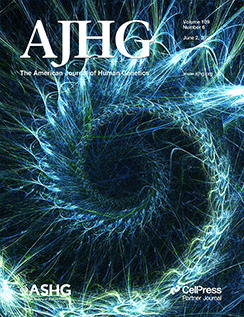Phenome-wide association study of male and female sex chromosome trisomies in 1.5 million participants of MVP, FinnGen, and UK Biobank
IF 8.1
1区 生物学
Q1 GENETICS & HEREDITY
引用次数: 0
Abstract
Sex chromosome trisomies (SCTs) are the most common whole-chromosome aneuploidy in humans. Yet, our understanding of the prevalence and associated health outcomes is largely driven by observational studies of clinically diagnosed individuals, resulting in a disproportionate focus on 47,XXY and associated hypogonadism. We analyzed microarray intensity data of sex chromosomes for 1.5 million individuals enrolled in three large cohorts—the Million Veteran Program, FinnGen, and UK Biobank—to identify individuals with 47,XXY, 47,XYY, and 47,XXX. We examined disease conditions associated with each SCT by performing phenome-wide association studies using electronic health records for each cohort, followed by meta-analysis across cohorts. We identified 2,769 individuals with SCTs (47,XXY: 1,319; 47,XYY: 1,108; and 47,XXX: 342), most of whom had no documented clinical diagnosis (47,XXY: 73.8%; 47,XYY: 98.6%; and 47,XXX: 93.6%). The identified phenotypic associations with SCT spanned all examined disease categories except neoplasms. Many associations are shared among three SCT subtypes, particularly for vascular diseases (e.g., chronic venous insufficiency [odds ratio (OR) (95% confidence interval [CI]) for 47,XXY: 4.7 (3.9,5.8), 47,XYY: 5.6 (4.5,7.0), and 47,XXX: 4.6 (2.7,7.6)]; venous thromboembolism [47,XXY: 4.6 (3.7–5.6), 47,XYY: 4.1 (3.3–5.0), and 47,XXX: 8.1 (4.2–15.4)]; and glaucoma [47,XXY: 2.5 (2.1–2.9), 47,XYY: 2.4 (2.0–2.8), and 47,XXX: 2.3 (1.4–3.5)]). A third sex chromosome confers an increased risk for systemic comorbidities, even if the SCT is not documented. SCT phenotypes largely overlap, suggesting that one or more X/Y homolog genes, possibly in the pseudoautosomal region, may underlie pathophysiology and comorbidities across SCTs.在MVP、FinnGen和UK Biobank的150万参与者中,男女性染色体三体的全现象相关性研究
性染色体三体(SCTs)是人类最常见的全染色体非整倍体。然而,我们对患病率和相关健康结果的理解在很大程度上是由临床诊断个体的观察性研究驱动的,导致对47,XXY和相关性腺功能减退的不成比例的关注。我们分析了三个大型队列(百万退伍军人计划,FinnGen和UK biobank)中150万人的性染色体微阵列强度数据,以识别具有47,XXY, 47,XYY和47,XXX的个体。我们通过对每个队列使用电子健康记录进行全现象关联研究来检查与每个SCT相关的疾病状况,然后进行跨队列的荟萃分析。我们确定了2,769例sct患者(47例,XXY: 1,319; 47例,XYY: 1,108; 47例,XXX: 342),其中大多数没有临床诊断(47例,XXY: 73.8%; 47例,XYY: 98.6%; 47例,XXX: 93.6%)。除肿瘤外,与SCT鉴定的表型关联跨越了所有被检查的疾病类别。许多关联在三种SCT亚型之间是共享的,特别是血管疾病(例如,慢性静脉功能不全[比值比(OR)(95%可信区间[CI])为47,XXY: 4.7 (3.9,5.8), 47,XYY: 5.6(4.5,7.0)和47,XXX: 4.6 (2.7,7.6)];静脉血栓栓塞[47,XXX: 4.6 (3.7-5.6), 47,XYY: 4.1 (3.3-5.0), 47,XXX: 8.1 (4.2-15.4)];和青光眼(47岁,XXY: 2.5(2.1 - -2.9), 47岁,XYY: 2.4(2.0 - -2.8),和47岁的XXX: 2.3(1.4 - -3.5)])。即使SCT没有记录,第三性染色体也会增加全身性合并症的风险。SCT表型在很大程度上重叠,表明可能在假常染色体区域的一个或多个X/Y同源基因可能是SCT病理生理和合并症的基础。
本文章由计算机程序翻译,如有差异,请以英文原文为准。
求助全文
约1分钟内获得全文
求助全文
来源期刊
CiteScore
14.70
自引率
4.10%
发文量
185
审稿时长
1 months
期刊介绍:
The American Journal of Human Genetics (AJHG) is a monthly journal published by Cell Press, chosen by The American Society of Human Genetics (ASHG) as its premier publication starting from January 2008. AJHG represents Cell Press's first society-owned journal, and both ASHG and Cell Press anticipate significant synergies between AJHG content and that of other Cell Press titles.

 求助内容:
求助内容: 应助结果提醒方式:
应助结果提醒方式:


